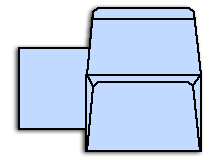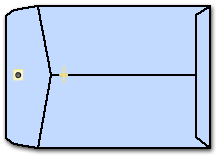ENVELOPE GUIDE

ANOUNCEMENTS
| TYPE | ENVELOPE SIZE |
| A2 | 5.75 x 4.375 |
| A6 | 6.5 x 4.75 |
| A7 | 7.25 x 5.25 |
| A8 | 8.125 x 5.5 |
| A10 | 9.5 x 6 |

BARONIALS
| TYPE | ENVELOPE SIZE |
| 4 Bar | 5.125 x 3.625 |
| 5 Bar | 5.5 x 4.125 |
| 5.5 Bar | 5.75 x 4.75 |
| 6 Bar | 6.5 x 4.75 |
| Lee | 7.25 x 5.25 |

REMITTANCE
Remittance envelopes offer a large flap that can be used for messages or offers. Most commonly used for tithe, coupon or direct mail applications.
| TYPE | ENVELOPE SIZE |
| 6 1/4 | 6 x 3.5 |
| 6 1/2 | 6.25 x 3.5 |
| 6 3/4 | 6.5 x 3.625 |
| 9 | 8.875 x 3.875 |

BOOKLET ENVELOPES
Booklet envelopes are top loaded along the long side.
| TYPE | ENVELOPE SIZE |
| 2 1/2 | 5.875 x 4.5 |
| 3 | 6.5 x 4.75 |
| 4 1/4 | 7.5 x 5 |
| 4 1/2 | 7.5 x 5.5 |
| 5 | 8.5 x 5.5 |
| 6 | 8.875 x 5.75 |
| 6 1/2 | 9 x 6 |
| 6 3/4 | 9.5 x 6.5 |
| 7 | 9.625 x 6.25 |
| 7 1/4 | 10 x 7 |
| 7 1/2 | 10.5 x 7.5 |
| 8 | 11.125 x 8 |
| 9 | 11.5 x 8.75 |
| 9 1/2 | 12 x 9 |
| 10 | 12.625 x 9.5 |
| 13 | 13 x 10 |

METAL CLASPS
| TYPE | ENVELOPE SIZE |
| 0 | 2.5 x 4.25 |
| 5 | 3.125 x 5.5 |
| 10 | 3.375 x 6 |
| 11 | 4.5 x 10.375 |
| 14 | 5 x 11.5 |
| 15 | 4 x 6.375 |
| 25 | 4.625 x 6.75 |
| 35 | 5 x 7.5 |
| 50 | 5.5 x 8.25 |
| 55 | 6 x 9 |
| 63 | 6.5 x 9.5 |
| 68 | 7 x 10 |
| 75 | 7.5 x 10.5 |
| 80 | 8 x 11 |
| 83 | 8.5 x 11.5 |
| 87 | 8.75 x 11.25 |
| 90 | 9 x 12 |
| 93 | 9.5 x 12.5 |
| 94 | 9.25 x 14.5 |
| 95 | 10 x 12 |
| 97 | 10 x 13 |
| 98 | 10 x 15 |
| 105 | 11.5 x 14. |
| 110 | 12 x 15.5 |

COMMERCIAL (STANDARD)
| TYPE | ENVELOPE SIZE |
| 5 | 5.5 x 3.0625 |
| 6 | 6 x 3.375 |
| 6 1/4 | 6 x 3.5 |
| 6 1/2 | 6.25 x 3.5625 |
| 7 | 6.75 x 3.75 |
| 7.5 | 7.625 x 3.75 |
| 7.75 | 7.5 x 3.875 |
| Data | 7.625 x 3.5 |
| 8 5/8 | 8.625 x 3.625 |
| 9 | 8.875 x 3.875 |
| 10 | 9.5 x 4.125 |
| 10 1/2 | 9.5 x 4.5 |
| 11 | 10.375 x 4.5 |
| 12 | 11 x 4.75 |
| 14 | 11.5 x 5 |

COMMERCIAL WINDOWS
| TYPE | ENVELOPE SIZE |
| 5 | 5.5 x 3.0625 |
| 6 | 6 x 3.375 |
| 6 1/4 | 6 x 3.5 |
| 6 1/2 | 6.25 x 3.5625 |
| 7 | 6.75 x 3.75 |
| 7.5 | 7.625 x 3.75 |
| 7.75 | 7.5 x 3.875 |
| Data | 7.625 x 3.5 |
| 8.625 | 8.625 x 3.625 |
| 9 | 8.875 x 3.875 |
| 10 | 9.5 x 4.125 |
| 10.5 | 9.5 x 4.5 |
| 11 | 10.375 x 4.5 |
| 12 | 11 x 4.75 |
| 14 | 11.5 x 5 |

CATALOG ENVELOPES
Catalog envelopes are side loaded along the short side.
| TYPE | ENVELOPE SIZE |
| 1 | 6 x 9 |
| 1 3/4 | 6.5 x 9.5 |
| 2 | 6.5 x 10 |
| 3 | 7 x 10 |
| 6 | 7.5 x 10.5 |
| 7 | 8 x 11 |
| 8 | 8.25 x 11.25 |
| 9 1/2 | 8.5 x 10.5 |
| 9 3/4 | 8.75 x 11.25 |
| 10 | 9 x 12 |
| 12 1/2 | 9.5 x 12.5 |
| 13 | 10 x 13 |
| 14 1/4 | 11.25 x 14.25 |
| 14 1/2 | 11.25 x 14.5 |

POLICY ENVELOPE
| TYPE | ENVELOPE SIZE |
| 9 | 4 x 9 |
| 10 | 4.125 x 9.5 |
| 11 | 4.5 x 10.375 |
| 12 | 4.75 x 10.875 |
| 14 | 5 x 11.5 |

COIN ENVELOPE
| TYPE | ENVELOPE SIZE |
| 1 | 2.25 x 3.5 |
| 3 | 2.5 x 4.25 |
| 4 | 3 x 4.5 |
| 4 1/2 | 3 x 4.875 |
| 5 | 2.875 x 5.25 |
| 5 1/2 | 3.125 x 5.5 |
| 6 | 3.125 x 6 |
| 7 | 3.5 x 6.5 |
TICKET ENVELOPE
| TYPE | ENVELOPE SIZE |
| 3 | 4.4375 x 1.3125 |
Interesting Envelope Facts
You probably hold an envelope every day but, have you ever thought about how the envelope came about, how we use them, or why they are the size they are?
Here are some interesting envelope facts:
- The very first envelopes date back to 3500 to 3200 B.C., when ancient people in the Middle East molded clay coverings over coins during business transactions.
- Paper envelopes were invented in 2nd century B.C. China, usually to enclose monetary gifts.
- Envelopes use to have four symmetrical flaps that met in the exact middle of the letter so that they could be closed and secured by a single wax seal.
- While envelopes can come in all manner of sizes and thicknesses, there are 13 standard envelope sizes in the United States.
- The most popular envelope size in the United States is the #10 envelope, which is 4⅛ inches by 9½ inches.
- Today, envelopes are made out of pieces of paper cut into one of three shapes: a rhombus, a short-armed cross, or a kite.
- In order to mail a letter using a single stamp, your envelope must be rectangular, at least 3-1/2 inches high by 5 inches long and no more than 6-1/8 inches high by 11-1/2 inches long by 1/4 inch thick.
- Window envelopes, in which a see-through panel allows the address on the letter to be visible to outside viewers, were invented by Americus F. Callahan of Chicago, Illinois. He patented his idea in 1902.
- Window envelopes were originally called “outlook envelopes.
- During the Civil War, many confederate soldiers fashioned envelopes out of wallpaper when traditional paper and envelopes were not available to them.
- Envelopes were handmade until 1840, when Englishman George Wilson invented a process in which envelope patterns were tiled over long sheets of paper. This made it easier for users to cut and assemble their own envelopes with more precision and less paper waste.
- In 1845, Edwin Hill and Warren de la Rue patented a mechanical process that cut out and folded envelopes (although gumming had to be added by hand).
- Each day, the United States Postal Service processes over 500 million letters each day. That is over 20 million each hour and over 5,000 every second.
- Envelopes can be folded in a variety of ways. The most popular folds today include the commercial flap, the square flap, the wallet flap, the side seam, the booklet, the catalog, and the policy.
DID YOU KNOW...
We are an OFFICIAL FEDEX SHIPPING/DROP OFF
ALL OUR LOCATIONS ARE OFFICIAL FEDEX DROPOFF SHIPPING LOCATIONS
Camelot Print & Copy Center/Copy A Second can ship you packages via FEDEX. Just come on in and let one of our staff assist you.
Questions or Requests?
Need some answers? Do have a request? Or maybe you want to just send us a comment about your experience with us. Fill out the form below and we will have a representative get back to you shortly.
